Root Barrier
Get Free Estimate
Trees and plants bring life and beauty to our surroundings, but their roots can sometimes cause problems that are anything but beautiful. If left unchecked, roots can damage foundations, sidewalks, driveways, and even underground utilities. That’s where root barriers come in, offering an effective way to control and redirect root growth before it causes damage. We’ll dive into how root barriers work, the different types available, and how to install them. Whether you’re a homeowner wanting to protect your property or a landscaper tasked with keeping things under control, this article will provide all the information you need to get started.
What is a Root Barrier?
A root barrier is a protective layer installed in the ground to prevent tree and plant roots from spreading into areas where they could cause damage. Made from materials like plastic, metal, or fabric, these barriers are designed to either block roots entirely or guide them in a different direction. The goal is simple: stop roots from reaching places they shouldn’t, such as building foundations, driveways, sidewalks, or underground pipes.
R.L.NELSON Foundation Solutions uses root barriers made from eco-friendly plastic or geotextile fabric, tailored to the specific site design. These barrier systems help redirect root growth without inhibiting natural root development and without significantly impacting other trees or plant life on your property.
Why Do You Need a Root Barrier?
Tree roots can be surprisingly destructive. They grow wherever they find moisture, which often leads them to foundations, pipes, and sidewalks. Over time, roots can lift concrete, break water lines, and even crack foundations. Without proper control, what starts as a small nuisance can quickly become an expensive problem.
Here are a few common issues that root barriers can help prevent:
By installing a root barrier, you create a physical block or redirection that keeps roots from causing damage where you don’t want them.
Types of Root Barriers
Not all root barriers are the same. Depending on your needs, you’ll find a variety of options on the market. Here are the main types:

How Root Barriers Work
Root barriers work by either completely blocking roots or forcing them to grow in a different direction. Here’s how each type operates:
Things to Consider Before Installing a Root Barrier
Before you get started with installing a root barrier, there are a few important factors to keep in mind:
Step-by-Step Installation Guide
Installing a root barrier isn’t too difficult, but it does take some planning and care. Follow these steps for a successful installation:
Step 1: Plan the Installation
First, decide where you need to install the root barrier. Identify the areas where you want to prevent root growth, such as along a foundation, sidewalk, or driveway. Mark out the line where the barrier will go.
Step 2: Dig a Trench
Use a shovel or trenching tool to dig a trench along the marked area. The trench should be deep enough to block the majority of the roots. Typically, trenches are about 18 to 36 inches deep, depending on the type of tree or plant and how deep its roots go.
Step 3: Place the Root Barrier
Once the trench is ready, place the root barrier vertically inside. Make sure the top of the barrier extends slightly above ground level so that roots can’t grow over it. If you’re using multiple pieces of barrier, overlap them slightly to prevent gaps.
Step 4: Backfill the Trench
After the barrier is in place, fill the trench back in with soil. As you backfill, compact the soil to make sure the barrier stays in position. If drainage is a concern, you can add a layer of sand or gravel to the bottom of the trench before placing the barrier.
Step 5: Water and Check
Water the area to help the soil settle around the barrier. Check to make sure the barrier remains straight and hasn’t shifted during the backfilling process. Adjust if necessary.

Maintenance and Durability
Once installed, root barriers typically require little to no maintenance. However, it’s a good idea to occasionally inspect the area for any signs of root growth pushing up above the barrier or gaps in the soil. Depending on the material, a root barrier can last anywhere from 10 to 30 years or longer.
Cost of Installing a Root Barrier
The cost of a root barrier installation or repair can vary depending on several key factors. These include whether the project is for a residential or commercial property, the size and scope of the job, and the type of material used. Additionally, site-specific conditions like soil type and root depth can also influence the final cost. For an accurate estimate, it’s always best to consult with a professional who can assess your unique situation and recommend the most effective solution.
If you want to protect your home or business from potential structural damage, contact R.L.NELSON Foundation solutions today at 281-949-6233 for more information.
